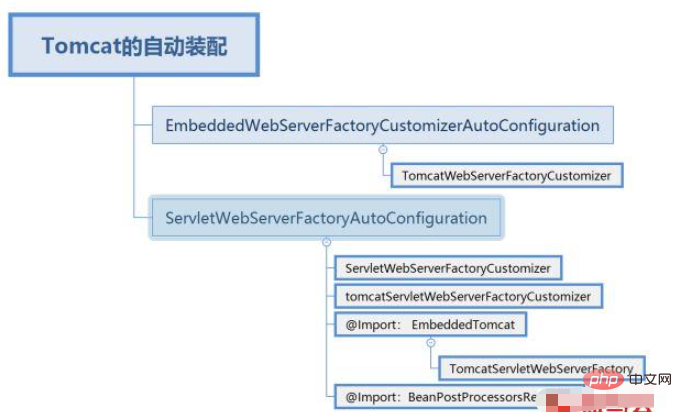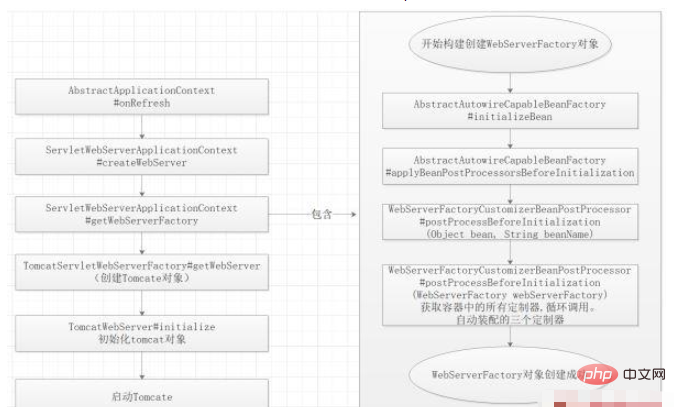
1 En implémentant l'interface ImportSerlector pour implémenter le chargement de Bean :
public class TestServiceImpl {
public void testImpl() {
System.out.println("我是通过importSelector导入进来的service");
}
}
public class TestService implements ImportSelector {
@Override
public String[] selectImports(AnnotationMetadata annotationMetadata) {
return new String[]{"com.ycdhz.service.TestServiceImpl"};
}
}
@Configuration
@Import(value = {TestService.class})
public class TestConfig {
}
public class TestController {
@Autowired
private TestServiceImpl testServiceImpl;
@RequestMapping("testImpl")
public String testTuling() {
testServiceImpl.testImpl();
return "Ok";
}
}2. pour implémenter le chargement du Bean :
public class TestService {
public TestService() {
System.out.println("我是通过ImportBeanDefinitionRegistrar导入进来的组件");
}
}
public class TestImportBeanDefinitionRegistrar implements ImportBeanDefinitionRegistrar {
@Override
public void registerBeanDefinitions(AnnotationMetadata importingClassMetadata, BeanDefinitionRegistry registry) {
//定义一个BeanDefinition
RootBeanDefinition beanDefinition = new RootBeanDefinition(TestService.class);
//把自定义的bean定义导入到容器中
registry.registerBeanDefinition("testService",beanDefinition);
}
}
@Configuration
@Import(TestImportBeanDefinitionRegistrar.class)
public class TestConfig {
}Nous avons recherché la configuration appropriée de Tomcat à partir de spring-boot-autoconfigure-2.0.6.RELEASE.jar et avons constaté qu'il existe deux configurations automatiques. classes d'assemblage Contient trois personnalisateurs (principe de responsabilité unique orienté objet) et une classe d'usine.

2.1, TomcatWebServerFactoryCustomizer : Personnalisez les fonctions spécifiques à Tomcat communes aux servlets et aux serveurs réactifs.
public class TomcatWebServerFactoryCustomizer implements
WebServerFactoryCustomizer<configurabletomcatwebserverfactory>, Ordered {
@Override
public void customize(ConfigurableTomcatWebServerFactory factory) {
ServerProperties properties = this.serverProperties;
ServerProperties.Tomcat tomcatProperties = properties.getTomcat();
PropertyMapper propertyMapper = PropertyMapper.get();
propertyMapper.from(tomcatProperties::getBasedir).whenNonNull()
.to(factory::setBaseDirectory);
propertyMapper.from(tomcatProperties::getBackgroundProcessorDelay).whenNonNull()
.as(Duration::getSeconds).as(Long::intValue)
.to(factory::setBackgroundProcessorDelay);
customizeRemoteIpValve(factory);
propertyMapper.from(tomcatProperties::getMaxThreads).when(this::isPositive)
.to((maxThreads) -> customizeMaxThreads(factory,
tomcatProperties.getMaxThreads()));
propertyMapper.from(tomcatProperties::getMinSpareThreads).when(this::isPositive)
.to((minSpareThreads) -> customizeMinThreads(factory, minSpareThreads));
propertyMapper.from(() -> determineMaxHttpHeaderSize()).when(this::isPositive)
.to((maxHttpHeaderSize) -> customizeMaxHttpHeaderSize(factory,
maxHttpHeaderSize));
propertyMapper.from(tomcatProperties::getMaxHttpPostSize)
.when((maxHttpPostSize) -> maxHttpPostSize != 0)
.to((maxHttpPostSize) -> customizeMaxHttpPostSize(factory,
maxHttpPostSize));
propertyMapper.from(tomcatProperties::getAccesslog)
.when(ServerProperties.Tomcat.Accesslog::isEnabled)
.to((enabled) -> customizeAccessLog(factory));
propertyMapper.from(tomcatProperties::getUriEncoding).whenNonNull()
.to(factory::setUriEncoding);
propertyMapper.from(properties::getConnectionTimeout).whenNonNull()
.to((connectionTimeout) -> customizeConnectionTimeout(factory,
connectionTimeout));
propertyMapper.from(tomcatProperties::getMaxConnections).when(this::isPositive)
.to((maxConnections) -> customizeMaxConnections(factory, maxConnections));
propertyMapper.from(tomcatProperties::getAcceptCount).when(this::isPositive)
.to((acceptCount) -> customizeAcceptCount(factory, acceptCount));
customizeStaticResources(factory);
customizeErrorReportValve(properties.getError(), factory);
}
}</configurabletomcatwebserverfactory>2.2. ServletWebServerFactoryCustomizer : WebServerFactoryCustomizer applique les propriétés ServerProperties au serveur Web Tomcat.
public class ServletWebServerFactoryCustomizer implements
WebServerFactoryCustomizer<configurableservletwebserverfactory>, Ordered {
private final ServerProperties serverProperties;
public ServletWebServerFactoryCustomizer(ServerProperties serverProperties) {
this.serverProperties = serverProperties;
}
@Override
public int getOrder() {
return 0;
}
@Override
public void customize(ConfigurableServletWebServerFactory factory) {
PropertyMapper map = PropertyMapper.get().alwaysApplyingWhenNonNull();
map.from(this.serverProperties::getPort).to(factory::setPort);
map.from(this.serverProperties::getAddress).to(factory::setAddress);
map.from(this.serverProperties.getServlet()::getContextPath)
.to(factory::setContextPath);
map.from(this.serverProperties.getServlet()::getApplicationDisplayName)
.to(factory::setDisplayName);
map.from(this.serverProperties.getServlet()::getSession).to(factory::setSession);
map.from(this.serverProperties::getSsl).to(factory::setSsl);
map.from(this.serverProperties.getServlet()::getJsp).to(factory::setJsp);
map.from(this.serverProperties::getCompression).to(factory::setCompression);
map.from(this.serverProperties::getHttp2).to(factory::setHttp2);
map.from(this.serverProperties::getServerHeader).to(factory::setServerHeader);
map.from(this.serverProperties.getServlet()::getContextParameters)
.to(factory::setInitParameters);
}
}</configurableservletwebserverfactory>2.3. ServletWebServerFactoryCustomizer : WebServerFactoryCustomizer applique les propriétés ServerProperties au serveur Web Tomcat.
public class TomcatServletWebServerFactoryCustomizer
implements WebServerFactoryCustomizer<tomcatservletwebserverfactory>, Ordered {
private final ServerProperties serverProperties;
public TomcatServletWebServerFactoryCustomizer(ServerProperties serverProperties) {
this.serverProperties = serverProperties;
}
@Override
public void customize(TomcatServletWebServerFactory factory) {
ServerProperties.Tomcat tomcatProperties = this.serverProperties.getTomcat();
if (!ObjectUtils.isEmpty(tomcatProperties.getAdditionalTldSkipPatterns())) {
factory.getTldSkipPatterns()
.addAll(tomcatProperties.getAdditionalTldSkipPatterns());
}
if (tomcatProperties.getRedirectContextRoot() != null) {
customizeRedirectContextRoot(factory,
tomcatProperties.getRedirectContextRoot());
}
if (tomcatProperties.getUseRelativeRedirects() != null) {
customizeUseRelativeRedirects(factory,
tomcatProperties.getUseRelativeRedirects());
}
}
}</tomcatservletwebserverfactory>Utilisez AbstractApplicationContext#onReFresh() pour conduire Tomcat à démarrer dans le conteneur IOC, puis exécutez d'autres étapes du conteneur IOC.
Nous pouvons observer tout le cycle de vie du chargement de Tomcat à travers des points d'arrêt, ainsi que le processus de chargement des trois personnalisateurs.

@Override
public WebServer getWebServer(ServletContextInitializer... initializers) {
Tomcat tomcat = new Tomcat();
File baseDir = (this.baseDirectory != null) ? this.baseDirectory
: createTempDir("tomcat");
tomcat.setBaseDir(baseDir.getAbsolutePath());
Connector connector = new Connector(this.protocol);
tomcat.getService().addConnector(connector);
customizeConnector(connector);
tomcat.setConnector(connector);
//设置是否自动启动
tomcat.getHost().setAutoDeploy(false);
//创建Tomcat引擎
configureEngine(tomcat.getEngine());
for (Connector additionalConnector : this.additionalTomcatConnectors) {
tomcat.getService().addConnector(additionalConnector);
}
//刷新上下文
prepareContext(tomcat.getHost(), initializers);
//准备启动
return getTomcatWebServer(tomcat);
}private void initialize() throws WebServerException {
TomcatWebServer.logger
.info("Tomcat initialized with port(s): " + getPortsDescription(false));
synchronized (this.monitor) {
try {
addInstanceIdToEngineName();
Context context = findContext();
context.addLifecycleListener((event) -> {
if (context.equals(event.getSource())
&& Lifecycle.START_EVENT.equals(event.getType())) {
// Remove service connectors so that protocol binding doesn't
// happen when the service is started.
removeServiceConnectors();
}
});
// Start the server to trigger initialization listeners
this.tomcat.start();
// We can re-throw failure exception directly in the main thread
rethrowDeferredStartupExceptions();
try {
ContextBindings.bindClassLoader(context, context.getNamingToken(),
getClass().getClassLoader());
}
catch (NamingException ex) {
// Naming is not enabled. Continue
}
// Unlike Jetty, all Tomcat threads are daemon threads. We create a
// blocking non-daemon to stop immediate shutdown
startDaemonAwaitThread();
}
catch (Exception ex) {
stopSilently();
throw new WebServerException("Unable to start embedded Tomcat", ex);
}
}
}Remarques : Dans ce processus, nous devons comprendre le cycle de vie du Bean Tomcat. Les trois personnalisateurs sont tous chargés dans le processus BeanPostProcessorsRegistrar (post-processeur Bean)
Méthode de construction-->Bean post ; Définition du processeurAvant-->InitializingBean-->init-method-->Bean post-processorAfter
org.springframework.beans.factory.support.AbstractAutowireCapableBeanFactory#doCreateBean org.springframework.beans.factory.support.AbstractAutowireCapableBeanFactory#initializeBean
protected Object doCreateBean(final String beanName, final RootBeanDefinition mbd, final @Nullable Object[] args)
throws BeanCreationException {
// Instantiate the bean.
BeanWrapper instanceWrapper = null;
if (mbd.isSingleton()) {
instanceWrapper = this.factoryBeanInstanceCache.remove(beanName);
}
if (instanceWrapper == null) {
//构造方法
instanceWrapper = createBeanInstance(beanName, mbd, args);
}
final Object bean = instanceWrapper.getWrappedInstance();
Class> beanType = instanceWrapper.getWrappedClass();
if (beanType != NullBean.class) {
mbd.resolvedTargetType = beanType;
}
// Initialize the bean instance.
......
return exposedObject;
}
protected Object initializeBean(final String beanName, final Object bean, @Nullable RootBeanDefinition mbd) {
if (System.getSecurityManager() != null) {
AccessController.doPrivileged((PrivilegedAction<object>) () -> {
invokeAwareMethods(beanName, bean);
return null;
}, getAccessControlContext());
}
else {
invokeAwareMethods(beanName, bean);
}
Object wrappedBean = bean;
if (mbd == null || !mbd.isSynthetic()) {
//Bean后置处理器Before
wrappedBean = applyBeanPostProcessorsBeforeInitialization(wrappedBean, beanName);
}
try {
invokeInitMethods(beanName, wrappedBean, mbd);
}
catch (Throwable ex) {
throw new BeanCreationException(
(mbd != null ? mbd.getResourceDescription() : null),
beanName, "Invocation of init method failed", ex);
}
if (mbd == null || !mbd.isSynthetic()) {
//Bean后置处理器After
wrappedBean = applyBeanPostProcessorsAfterInitialization(wrappedBean, beanName);
}
return wrappedBean;
}</object>Ce qui précède est le contenu détaillé de. pour plus d'informations, suivez d'autres articles connexes sur le site Web de PHP en chinois!
 Étapes de création du projet SpringBoot
Étapes de création du projet SpringBoot
 Comment configurer les variables d'environnement Tomcat
Comment configurer les variables d'environnement Tomcat
 Comment intégrer l'idée avec Tomcat
Comment intégrer l'idée avec Tomcat
 Comment afficher le code source de Tomcat
Comment afficher le code source de Tomcat
 Quelles sont les vulnérabilités courantes de Tomcat ?
Quelles sont les vulnérabilités courantes de Tomcat ?
 Comment résoudre les journaux Tomcat tronqués
Comment résoudre les journaux Tomcat tronqués
 Quelles sont les différences entre weblogic et Tomcat
Quelles sont les différences entre weblogic et Tomcat
 Quelles sont les différences entre Tomcat et Nginx
Quelles sont les différences entre Tomcat et Nginx